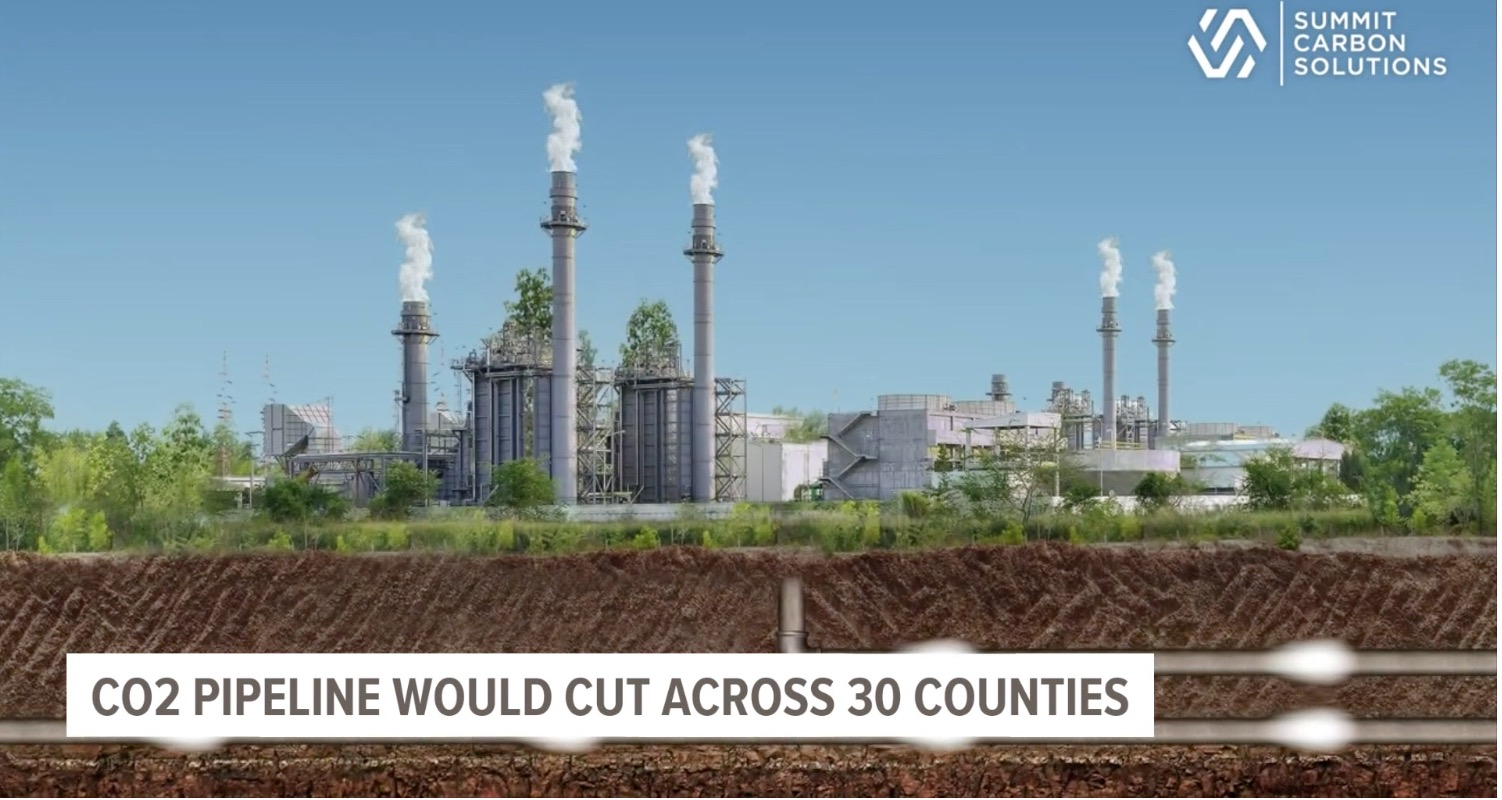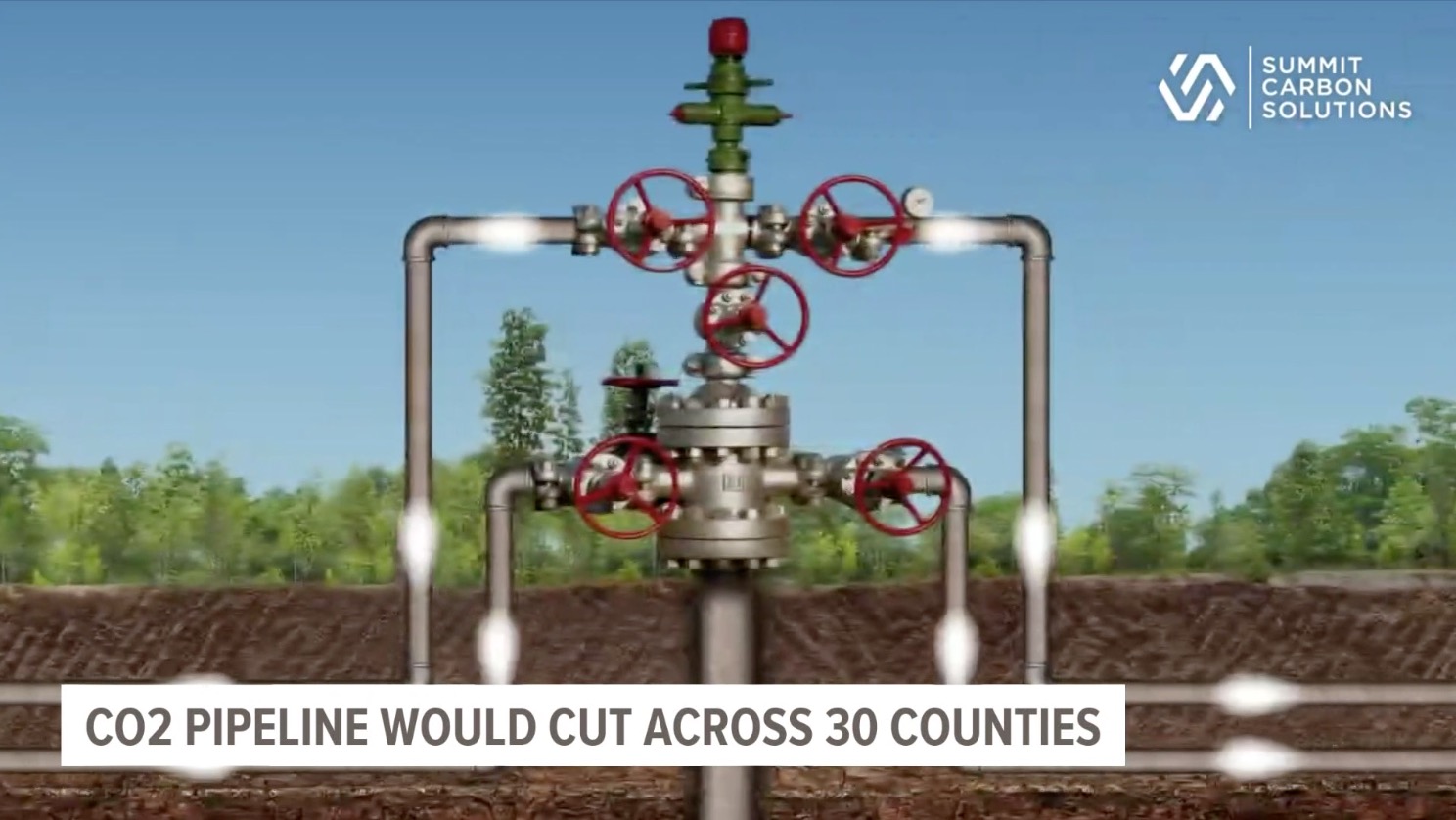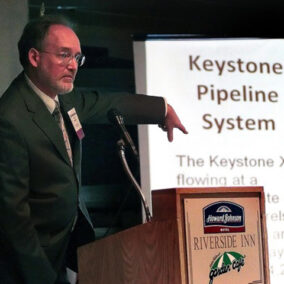Double-Dipping of Federal Tax Credits for Carbon Pipelines?

Paul Blackburn is an attorney specializing in pipeline law who has represented community and environmental groups including Bold Alliance for over a decade on pipeline projects. He previously worked for a number of environmental organizations, as well as in renewable and fossil fuel energy project development.
 Summit Carbon Solutions argues that state regulators should rush approval of its carbon pipeline applications because it needs to build now so that its contracted ethanol plants can exploit the 45Z tax credit before it expires in 2027. Section 45Z of the tax code provides a tax credit of up to $1.00 for each gallon of low-carbon ethanol produced, and up to $1.75 for each gallon of low-carbon aviation fuel. Yet, it is unlikely that Summit’s contracted ethanol plants will be eligible to exploit the 45Z tax credit, such that there is no reason to rush the pipeline applications on its account.
Summit Carbon Solutions argues that state regulators should rush approval of its carbon pipeline applications because it needs to build now so that its contracted ethanol plants can exploit the 45Z tax credit before it expires in 2027. Section 45Z of the tax code provides a tax credit of up to $1.00 for each gallon of low-carbon ethanol produced, and up to $1.75 for each gallon of low-carbon aviation fuel. Yet, it is unlikely that Summit’s contracted ethanol plants will be eligible to exploit the 45Z tax credit, such that there is no reason to rush the pipeline applications on its account.
The short answer: 26 U.S.C. § 45Z(d)(4)(B)(iii) contains an anti-double dipping provision that prohibits transportation fuel production facilities that “allow” use of the 45Q carbon capture tax credit from also claiming the 45Z tax credit. The interpretation of this provision impacts not only carbon dioxide pipeline development, but also the efficacy of carbon capture commercial models, and the competitive positions of low-carbon fuel producers.
What is the 45Z tax credit?
The 45Z tax credit is a new federal tax break included in the Inflation Reduction Act passed by Congress on August 16, 2022. Pub. L. 117–169, title I, § 13704(a), Aug. 16, 2022, 136 Stat. 1997 (this is a very long law, so after opening the links search for “45Z” using your browser’s search function). It is codified at 26 U.S. Code § 45Z. The purpose of this tax credit is to provide a financial incentive to produce low-carbon transportation fuels.
This law grants a fuel producer, who uses a qualified facility to produce a transportation fuel that is low-carbon ethanol, biodiesel, or sustainable aviation fuel, and who registers under 26 U.S.C. § 4101, to reduce its federal taxes by $1.00 per gallon of fuel produced, assuming the fuel producer meets certain wage and apprenticeship standards, and otherwise $0.20 per gallon. 26 U.S.C. § 45Z(a)(2). For low-carbon sustainable aviation fuel the tax credit increases to $1.75 per gallon when meeting wage and apprenticeship standards, and $0.35 per gallon otherwise. 26 U.S.C. § 45Z(a)(3). The law automatically adjusts these amounts for inflation. 26 U.S.C. § 45Z(c).
Where more than one person has an ownership interest in a fuel production facility, the tax credit will be allocated among persons who own the facility in proportion to their ownership interests. 26 U.S.C. § 45Z(f)(2). This may include ownership through corporations, partnerships, and trusts and estates, and the tax credits may also be claimed by patrons of agricultural cooperatives. 26 U.S.C. § 45Z(f)(2), (4) and (5).
The tax credit is available for transportation fuel sold through the end of 2027, though of course it would be reasonable to expect those who benefit from the tax credit to lobby Congress for an extension.
How Generous Is the 45Z Tax Credit?
At present, ethanol producers are paid about $2.20 per gallon for ethanol. Being allowed to write off $1.00 in taxes for each gallon of ethanol produced likely means that the federal government will subsidize most of the cost of production. The 45Z tax credit appears to make producing low-carbon biodiesel and ethanol highly profitable.
How Does the 45Z Tax Credit Relate to Proposed Carbon Capture Pipelines?
Supporters of the Summit Pipeline claim that if state regulators do not approve the project quickly, the connected ethanol plants won’t be able to exploit the 45Z tax credit before it expires in 2027. However, if Summit’s contracted ethanol plants are ineligible to claim the 45Z tax credit, then it bears no relationship to the proposed carbon capture pipeline.
Does the 45Z Tax Credit Allow Ethanol Plants to Double Dip Both the 45Q and 45Z tax credits?
 The short answer is, probably not, but the IRS may need to provide guidance on double dipping. The 45Z tax credit statute contains language that prohibits double dipping of the 45Q and 45Z tax credits. Specifically, 26 U.S.C. § 45Z(d)(4) defines a qualified facility as “a facility used for the production of transportation fuels, and . . . does not include any facility for which one of the following credits is allowed under section 38 for the taxable year: . . . The credit for carbon oxide sequestration under section 45Q.” If a low-carbon transportation fuel production facility “allows” a taxpayer to claim 45Q carbon capture tax credits, that facility is not qualified to claim the 45Z tax credit.
The short answer is, probably not, but the IRS may need to provide guidance on double dipping. The 45Z tax credit statute contains language that prohibits double dipping of the 45Q and 45Z tax credits. Specifically, 26 U.S.C. § 45Z(d)(4) defines a qualified facility as “a facility used for the production of transportation fuels, and . . . does not include any facility for which one of the following credits is allowed under section 38 for the taxable year: . . . The credit for carbon oxide sequestration under section 45Q.” If a low-carbon transportation fuel production facility “allows” a taxpayer to claim 45Q carbon capture tax credits, that facility is not qualified to claim the 45Z tax credit.
This anti-double dipping language clearly intends to prohibit simultaneous exploitation of the 45Q and 45Z tax credits. But, what happens when the carbon capture equipment installed at an ethanol plant is not owned by the ethanol plant? In this case, the ethanol plant would not claim the 45Q credit, and instead, it would be claimed by whomever owns the carbon capture equipment. In this circumstance, could an ethanol plant claim the 45Z tax credit while at the same time the owners of the carbon capture equipment installed at the plant claim the 45Q tax credit?
It appears that Summit Carbon Solutions believes that its contracted ethanol plants may claim the 45Z tax credit, even while Summit is claiming the 45Q tax credit. It might argue that because the ethanol plant owner would not claim the 45Q tax credit, that therefore it should be allowed to claim the 45Z tax credit. The argument here would be that there is no double dipping by a taxpayer, because two separate taxpayers, the fuel production facility and a third-party owner of the attached carbon capture equipment, would claim the 45Z and 45Q tax credits, respectively and separately.
The IRS is not likely to agree with this pro-double dipping argument, and instead will likely prohibit 45Z claims by any fuel producer that allows its carbon to be captured for 45Q tax credit claims.
First, the anti-double dipping language in § 45Z(d)(4) is based on whether a transportation fuel producing facility “allows” use of the 45Q tax credit, and not on whether a particular taxpayer attempts to claim both tax credits. The anti-double dipping provision is not based on taxpayer identity; it is based on whether a fuel facility’s carbon dioxide is also used to claim 45Q tax credits. The anti-double dipping clause does not say that taxpayers who claim the 45Q tax cannot claim the 45Z tax credit. It says that facilities that allow use of the 45Q tax credit may not also claim the 45Z tax credit. Taxpayers are not allowed under 26 U.S.C. § 38, subsection (b), which lists the types of tax credits that may be added together on tax returns, to claim both the 45Q and 45Z tax credits. If a transportation fuel production facility “allows” any taxpayer to acquire 45Q tax credits, it is not qualified to receive the 45Z tax credit.
Second, the clear intent of Congress in passing this anti-double dipping language is to prevent ethanol plants from exploiting both the 45Q and 45Z tax credit. If this language did not exist, then all ethanol plants with carbon capture equipment could claim a 45Q tax credit of $85 or $60 per metric ton of carbon emitted PLUS a 45Z tax credit of $1.00 per gallon. An interpretation of the anti-double dipping rule that allows use of both tax credits at a single facility would frustrate congressional intent.
Third, when a low-carbon fuel production facility allows a third-party to install and own carbon capture equipment, presumably the fuel production facility would receive a financial benefit from transferring title to its carbon dioxide to the third-party, because the right to this stream would become the basis for the valuable 45Q tax credit. The low carbon fuel producer would indirectly benefit from the 45Q tax credit, even if it does not itself claim the 45Q tax credits. A transfer of the right to claim the 45Q tax credit to a third-party would simply convert the form of the financial benefit received by the fuel production facility from a 45Q tax credit to some other financial benefit, such as a cash payment for the carbon dioxide waste stream. If third-party ownership of carbon capture equipment allows double dipping, then essentially all low-carbon transportation fuel facility owners would transfer ownership of carbon dioxide capture equipment to third-parties, thereby allowing double dipping at all such facilities, which would leave the anti-double dipping language without practical effect.
Fourth, if the 45Z tax credit is not allowed at a low-carbon fuel facility that owns installed carbon capture equipment, but is allowed where a third-party owns the carbon capture equipment, then the IRS would provide a huge incentive for third-party ownership of carbon capture equipment. Such interpretation would likely mean that no low-carbon fuel production facility would in the future choose to own the carbon capture equipment installed at its facilities, and it would disadvantage existing CCS projects that are commercially based on fuel producer ownership of carbon capture equipment, such as the Navigator Greenway project. There is no indication that Congress intended Section 45Z to have the practical effect of discouraging fuel producer ownership of carbon capture equipment.
Fifth, Congress intended the 45Z tax credit to be a way to support low-carbon transportation fuel facilities that, for whatever reason, are not able to exploit the 45Q tax credit, for example by being too remote from carbon capture projects, or by producing too little carbon dioxide to make carbon capture economic. Congress enacted the anti-double dipping law so that the 45Z program would level the playing field between CCS-based low-carbon fuel producers and other producers. If fuel producers that benefit either directly or indirectly from the 45Q tax credit can also claim the 45Z tax credit, then fuel producers that claim only the 45Z tax credit may be squeezed out of the market. Congress did not intend to give fuel production facilities with carbon capture equipment a major tax advantage over facilities that are unable to benefit from the 45Q tax credit.
Sixth, the 45Q tax credit will likely provide ethanol-based carbon capture projects, such as the Summit and Navigator projects, with annual profits in the hundreds of millions of dollars. Adding the 45Z tax credit on top would be profoundly wasteful of federal tax dollars.
Any low-carbon fuel producer that allows its carbon dioxide emissions to be captured to exploit the 45Q tax credit likely could not also exploit the 45Z tax credit.
Would the Summit and Navigator Carbon Capture Projects and Their Contracted Ethanol Producers Be Allowed to Double Dip the 45Q and 45Z Tax Credits?
The ethanol plants contracted with the Summit and Navigator CCS projects likely cannot claim the 45Z tax credit. But, since these projects appear to have different carbon capture equipment ownership structures, the reasons that each may not double dip are somewhat different.
The Navigator CCS project is commercially structured so that the connected ethanol facilities would themselves own the installed capture equipment. Navigator, as the pipeline and sequestration site operator, would be a transportation and sequestration service provider. In this case, it seems clear enough that Navigator-contracted ethanol facility owners could not claim both the 45Q and 45Z tax credits.
Based on testimony filed with the South Dakota Public Utilities Commission, it appears that the Summit project is commercially structured so that a subsidiary of Summit Carbon Solutions would own the capture equipment at its contracted ethanol facilities. Therefore, Summit would claim the 45Q tax credits, and its contracted ethanol facilities would not. Presumably, these ethanol plants would receive compensation of some sort from Summit for their CO2. Nonetheless, Summit could argue that because its contracted ethanol plants do not themselves claim the 45Q tax credit, such plants could instead claim the 45Z tax credit. However, for the reasons stated above, the IRS will likely not allow the ethanol plants contracted with Summit to claim the 45Z tax credit. As such, the 45Z tax credit is not a reason to rush state and local permitting of the Summit project.
Ultimately, the interpretation of the 45Z anti-double dipping provision is up to the IRS and the courts. Until they provide greater clarity, it would seem imprudent for ethanol plants that are contracted with CCS pipeline projects to plan on claiming the 45Z tax credit. Counting on a $1.00 per gallon tax credit only to have it be clawed back by the IRS would be a financial disaster.








